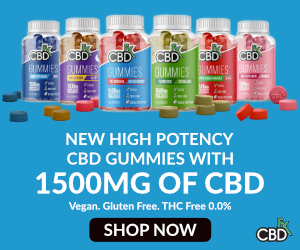QUICK LINKS
VG (Vegetable Glycerin) vs PG (Propylene Glycol)
When comparing VG and PG, the two primary ingredients in e-juice, consistency becomes a defining factor.
VG offers a thicker texture and produces dense vape clouds. PG, being less viscous, carries flavor better, provides a stronger throat hit, but with less vapor.
Choosing the right ratio depends on your vaping preference of flavor intensity, cloud production, or throat sensation.
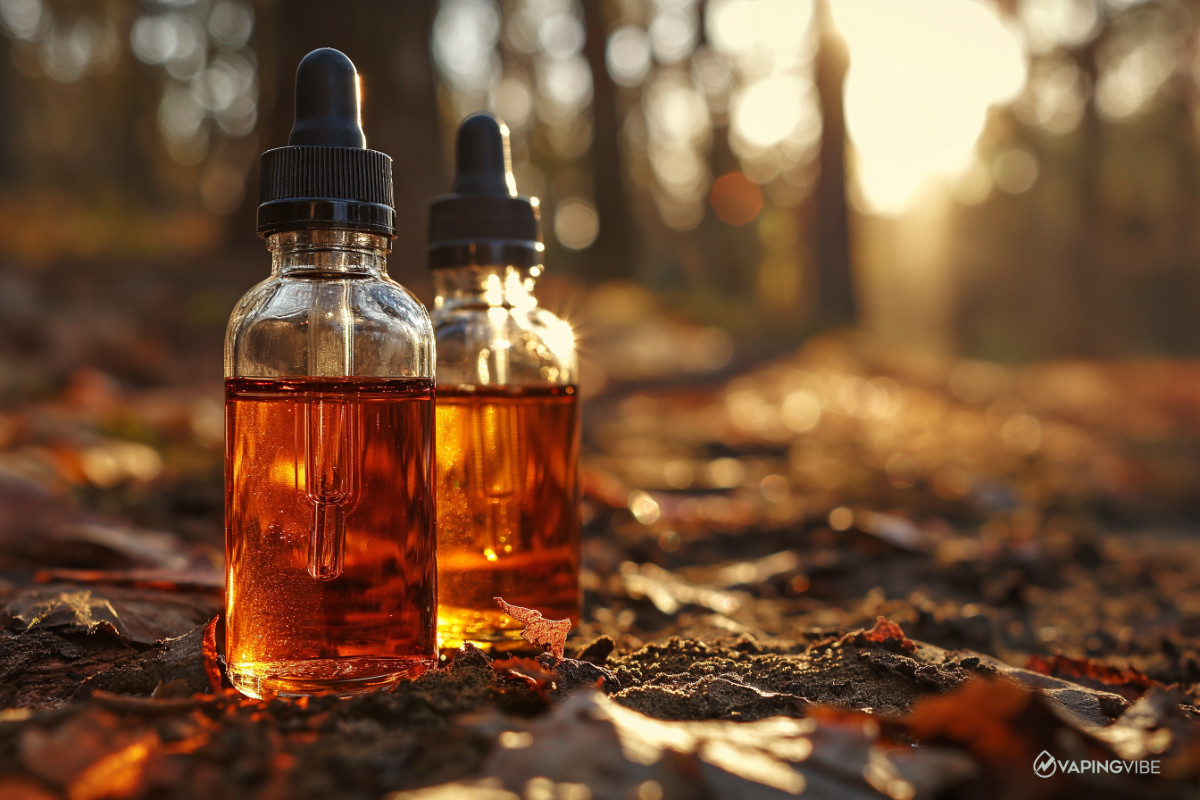
What are PG and VG?
- PG (Propylene Glycol) and VG (Vegetable Glycerin) are key ingredients in e-juice, contributing to its texture and vapor.
- Though categorized under the alcohol class, neither PG nor VG are intoxicants.
- These compounds are types of sugar alcohols, found in various edible items.
- When subjected to heat, PG and VG are aerosolized, transforming into vapors suitable for inhalation.
- PG and VG are not oils. They aren’t linked to conditions such as lipoid pneumonia resulting from oil inhalation1S. J. Laugesen, “Safety Report on the Ruyan® e-cigarette Cartridge and Inhaled Aerosol,” Health New Zealand Ltd, Christchurch, New Zealand, 2008. [Online]. Available: https://www.researchgate.net/publication/237451220_Safety_Report_on_the_RuyanR_e-Cigarette_and_Inhaled_Aerosol
- While both are liquids, their textures and flavors differ slightly.
- Vaping them can lead to varied sensations in the mouth and throat.
- Most contemporary e-liquids mix both PG and VG, but the proportions can differ significantly.
- Some devices designed for novices have specific PG and VG requirements.
Selecting an unsuitable PG/VG mix might discourage newcomers. Always match the mix to your device’s specs.Let’s look more in-depth at both ingredients and how to choose the best ratio.
PG (Propylene Glycol)
What is PG?
PG stands for propylene glycol, a by-product of petroleum. While the main source is petroleum, some labs produce synthetic PG. Its Molecular Formula is C3H8O2.
Propylene Glycol is odorless, colorless, and less thick (or viscous) than VG.
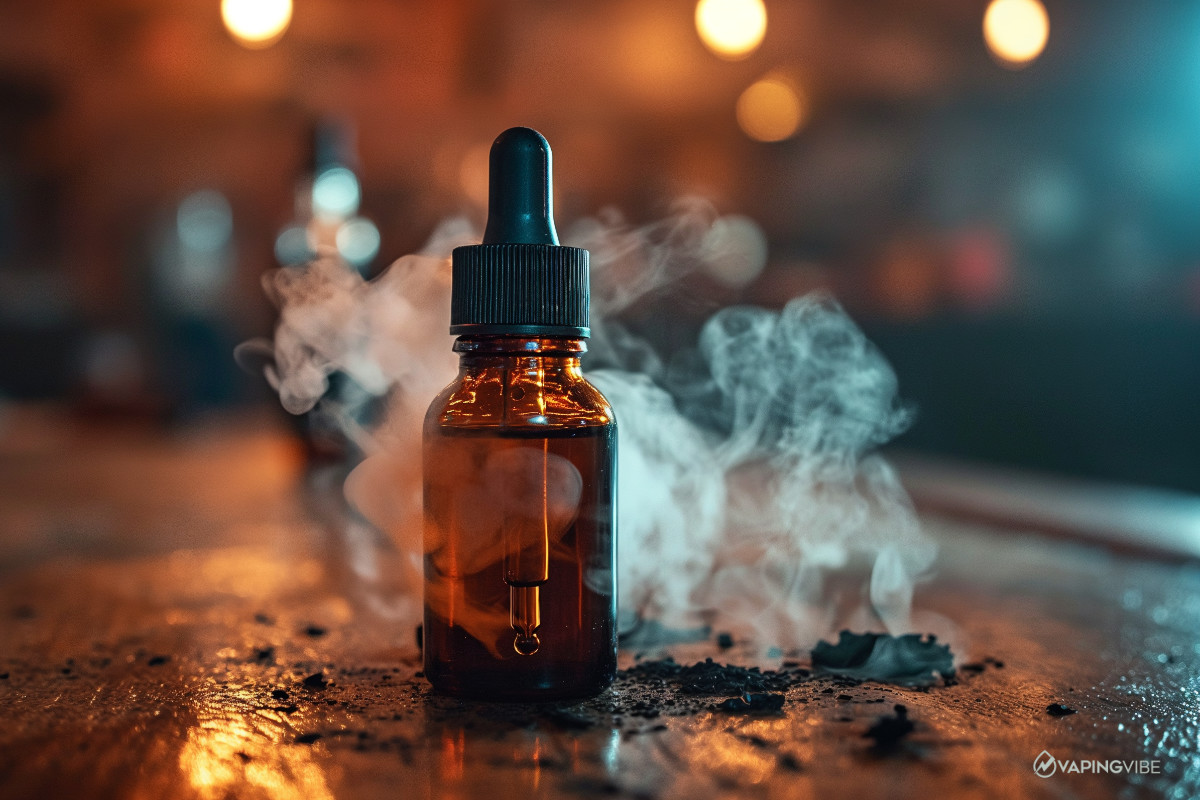
How is PG made?
Propylene glycol is made in labs. It can come from propylene oxide or be a side product of biodiesel making.
PG can come from biodiesel. But this type is not considered food grade and isn’t for e-liquids.
PG use in Vaping
PG is a base liquid in vape juices.
PG serves as a solvent, dissolving compounds like flavors. It’s favored for delivering intense flavors and a strong throat hit similar to traditional cigarettes2J. W. Harvanko, A. V. Sharma, J. M. Havel, and P. A. Jacob III, “Stimulus effects of propylene glycol and vegetable glycerin in electronic cigarette liquids,” Drug Alcohol Depend., vol. 204, Dec. 2019. [Online]. Available: https://pubmed.ncbi.nlm.nih.gov/30471584/.
PG has a mild sweetness, making high-PG e-liquids suitable for dessert or candy flavors.
E-liquids with over 20% PG concentration can resist microbial growth, preserving the vape juice’s quality.
Other PG uses
Propylene Glycol (PG) is a versatile component found in many products. It’s commonly used as a food additive and also finds applications in the pharmaceutical and cosmetics sectors.
- Toothpaste
- Other oral hygiene items
- Oral, injectable, and topical medical formulations
- A range of pet foods (not including cat food)
- Shampoo
- Baby wipes
- Make-up items
- Nicotine inhaler
Its preservative properties make it popular in food and medicine. Since it’s tasteless, it’s a preferred addition to foods like popcorn, some breads, soft drinks, and more.
As an emulsifier, PG ensures ingredients mix well.
PG’s ability to retain moisture prevents products from drying. This benefits foods, moisturizers, and e-liquids with high PG content.
PG’s ability to retain moisture prevents products from drying. This benefits foods, moisturizers, and e-liquids with high PG content.

Is PG safe?
The PG used in e-liquids differs from the non-food grade variety found in biodiesel production. E-liquid PG is produced in labs.
In 1973, the Food and Drug Administration (FDA) labeled propylene glycol3J. B. Finks and M. D. Finks, “Propylene Glycol,” in LiverTox: Clinical and Research Information on Drug-Induced Liver Injury, Bethesda (MD): National Institute of Diabetes and Digestive and Kidney Diseases, 2012. [Online]. Available: https://www.ncbi.nlm.nih.gov/books/NBK507184/ as Generally Recognized As Safe (GRAS)4U.S. Food and Drug Administration, “Generally Recognized as Safe (GRAS),” [Online]. Available: https://www.fda.gov/food/food-ingredients-packaging/generally-recognized-safe-gras. To earn this status, experts confirmed the substance’s safety for its intended purpose.
A study from 2010 on PGEs5I. Burstyn, “Peering through the mist: systematic review of what the chemistry of contaminants in electronic cigarettes tells us about health risks,” BMC Public Health, vol. 14, no. 18, Jan. 2014. [Online]. Available: https://www.ncbi.nlm.nih.gov/pmc/articles/PMC2956675/, which are mixtures of propylene glycol and glycol ethers, suggested a link to respiratory and immune issues in children, like asthma and hay fever. Yet, it’s the glycol ethers, not the PG, that likely caused these problems. Although most signs point to PG being safe to inhale, we need more detailed studies.
PG is safe for us and even as a food additive for dogs6Office of the Federal Register, National Archives and Records Administration, “21 CFR 582.1666 – Propylene Glycol,” in Code of Federal Regulations, Title 21, vol. 6, 2009. [Online]. Available: https://www.gpo.gov/fdsys/pkg/CFR-2009-title21-vol6/xml/CFR-2009-title21-vol6-sec582-1666.xml. But for cats, it’s a different story. It can cause Heinz body anemia7D. S. Lester, S. C. Green, and R. C. Scurlock, “Acute toxic effects of ‘inert’ ingredients in children’s soap bubbles,” Pediatrics, vol. 84, no. 2, pp. 322-324, Aug. 1989. [Online]. Available: https://www.ncbi.nlm.nih.gov/pubmed/2708106. So, be careful vaping around cats, especially with PG e-liquids.
Potential risks
About 1 in 10 people might be sensitive to propylene glycol. Notably, in 2018, the American Contact Dermatitis Society (ACDS) named it Allergen of the Year8J. P. Farsalinos, K. Poulas, M. Voudris, and C. Le Houezec, “E-cigarettes: An evidence update. A report commissioned by Public Health England,” Public Health England, Aug. 2015. [Online]. Available: https://pubmed.ncbi.nlm.nih.gov/29059092/. Those with PG sensitivity can experience symptoms such as sore throat, rash, or coughing.
Allergic Reactions to PG:
While Propylene Glycol (PG) is generally safe for most vapers, a small percentage might experience allergic reactions, especially those with conditions like asthma, or eczema.
Symptoms can range from minor irritations, like a sore throat or skin flare-ups, to more severe reactions such as hives, difficulty breathing, or asthma exacerbations.
If you suspect an allergic reaction, it’s essential to consult with a healthcare professional. For those sensitive to PG, VG-dominant or 100% VG e-liquids might be a better choice.
VG (Vegetable Glycerine)
What is VG?
VG stands for Vegetable Glycerin. It’s made when you combine fat and lye in soap-making. Its molecular formula is C3H8O3.
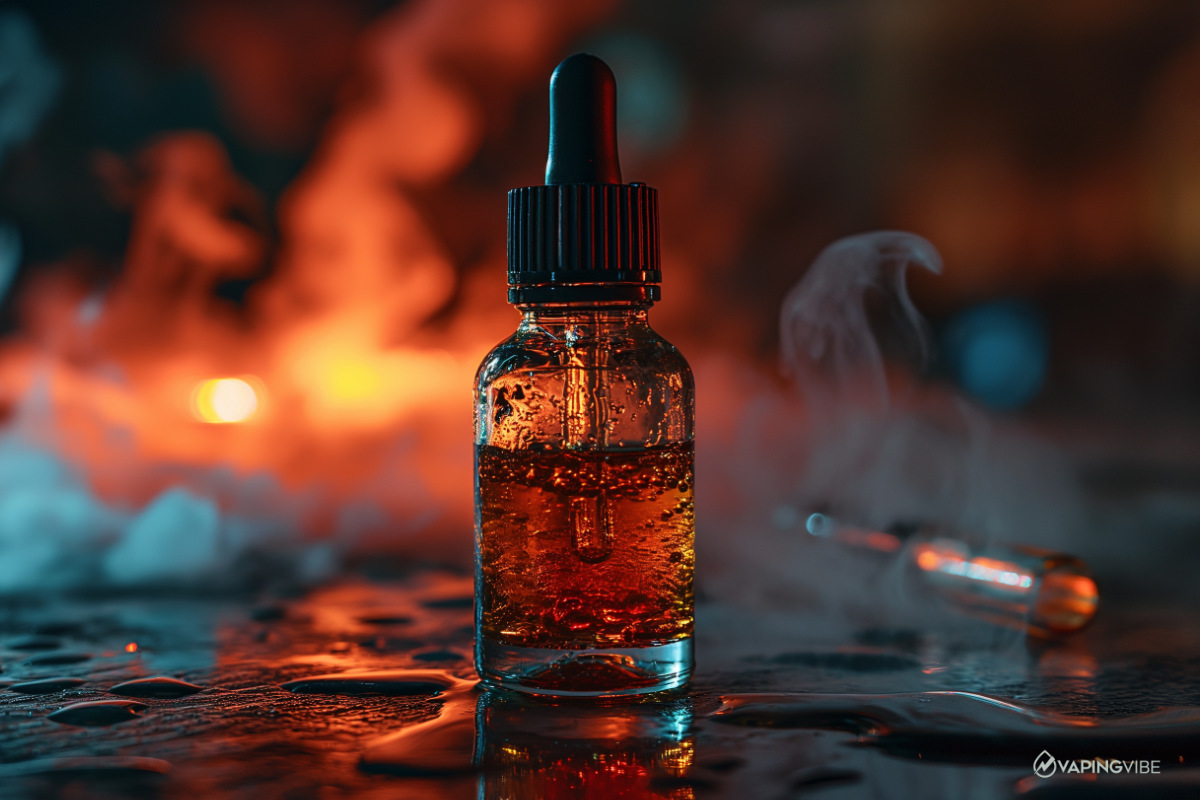
How is VG made?
Vegetable glycerin is a natural product, not a man-made one. When you mix lye with fat, you get soap and glycerin. Some glycerin goes back into the soap to moisturize. The rest is used differently.
VG use in Vaping
VG is a base liquid in vape juices.
VG, due to its higher viscosity, is sweeter and thicker than PG. It gives a smooth feeling in the throat and produces thick clouds. This property is one reason many choose it for sub-ohm vaping.
VG is much thicker than PG. So, it needs more power to turn into vapor. This is why it gives more vapor.
The thickness of VG can change how e-liquids work with atomizers and coils. This might make the coils last a shorter time.
Other VG uses
Like propylene glycol, vegetable glycerine is an ingredient in many products, not just e-juice:
- Hand cream
- Pet food
- Make-up
- Bubble bath
- Personal care products like aftershave and deodorant
- Oral hygiene products like toothpaste
- Baked goods
- Products that need sweeteners
Derived from vegetable oils, VG shares many properties with propylene glycol. Both act similarly in blending ingredients and keeping moisture.

Is VG safe?
Yes, it is! There’s minimal evidence linking VG to harmful effects or long-term health issues.
Both research and the FDA concur that vegetable glycerin is safe to consume9U.S. Food and Drug Administration, “Title 21 – Food and Drugs, Chapter I – Food and Drug Administration, Department of Health and Human Services, Subchapter B – Food for Human Consumption, Part 182 – Substances Generally Recognized as Safe, Sec. 182.1320 Glycerin,” Code of Federal Regulations, Apr. 2023. [Online]. Available: https://www.accessdata.fda.gov/scripts/cdrh/cfdocs/cfcfr/CFRSearch.cfm?fr=182.1320&SearchTerm=glycerin. For vapers, the main point is its “generally recognized as safe” status.
VG, widely used in everyday products, rarely causes severe side effects. Its widespread use in vaping without significant problems underscores its safety.
Potential risks
Allergic reactions to VG are uncommon. However, if you’re sensitive to coconut or palm oil, be careful with high VG e-liquids10C. Burnett, W. Bergfeld, D. Belsito, R. Klaassen, J. Marks Jr, R. Shank, T. Slaga, P. Snyder, and F. Alan Andersen, “Safety Assessment of Glycerin as Used in Cosmetics,” Int. J. Toxicol., vol. 38, no. 3_suppl, pp. 6S-22S, Sep. 2019. [Online]. Available: https://pubmed.ncbi.nlm.nih.gov/31840548/. Many prefer a balanced VG/PG mix.
Diabetics might find it challenging to process VG. But considering the concentration in even high VG e-liquids, this is usually not an issue. Always get informed before trying a new substance.

Can I Mix PG and VG?
Absolutely! PG and VG form the primary base of e-liquids. An e-liquid can contain only VG, only PG, or both, along with nicotine and flavors. Both VG and PG are emulsifiers, helping them and other ingredients blend smoothly.
Creating your own vape juice is a more complex task. While you can buy both ingredients in bulk to make e-liquids, it’s essential to understand the process. You can follow our DIY Vape juice article to guide you through potential challenges.
Beginners Vapers & MTL Ratios
Most beginner vapers use e-cigarettes with a mouth-to-lung (MTL) vaping technique, which feels like smoking a traditional cigarette.
Some beginner vapes can only work with a certain ratio of VG and PG vape juice.
Most choose a 50:50 blend, using freebase or nic salt e-liquid. This ratio provides the throat hit familiar to smokers.
The 50:50 ratio works well with beginner devices such as pod vapes, vape pens, and disposables.
Features of a 50:50 ratio:
- The blend is thinner, making it easy to vaporize in low-power kits.
- Provides a strong throat hit.
- Works well with high nicotine levels (both freebase and nic salts).
- It has a good flavor due to the balanced ratio.
- It gives off less vapor, making it discreet for public use.
Sub-ohm vaping & High VG liquids
High VG e-liquids usually have 70% VG or more. Max VG liquids will be 100%.
Many switch to High VG after vaping for some time. But light or social vapers might start with it.
High VG juice is ideal for sub-ohm vaping because using higher power devices with high PG can result in an overly harsh throat hit.
Key things to note about high VG e-liquid:
- High VG fluids are thick, so they are better suited to high powered sub-ohm devices.
- They will deliver dense vape clouds, but a very subtle throat hit.
- VG liquids don’t carry flavor as well as PG. So, makers might add sweeteners, but this can harm coils.
- High VG e-liquids and nic salt don’t mix well. In powerful kits, the nicotine feel can be too much.
- Pick a ratio based on your preference. Want more flavor? Go 30:70. For more vapor, try 20:80.
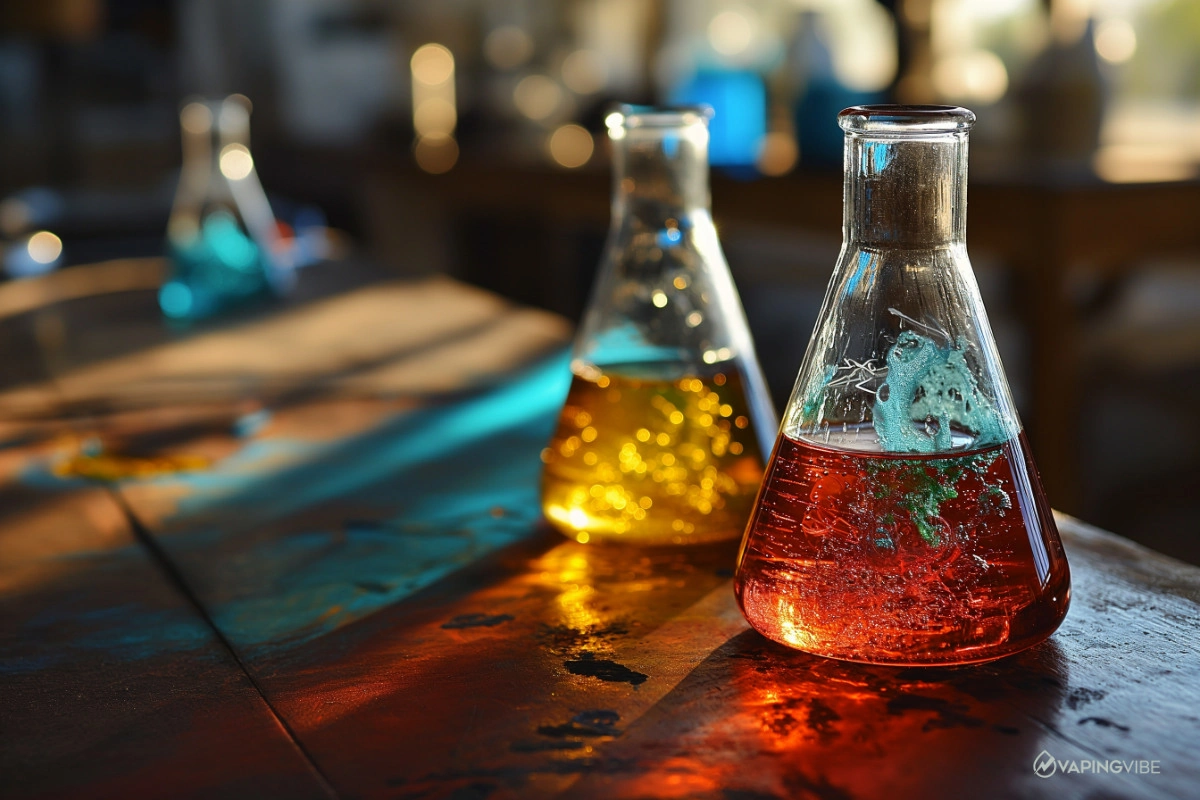
Choosing the Right PG/VG Ratio for You:
Your ideal PG/VG ratio depends on your preferences:
- Flavor and Throat Hit: If you’re after a strong flavor and a pronounced throat hit reminiscent of smoking, consider a higher PG ratio.
- Cloud Production: For those who enjoy cloud chasing or simply prefer a smoother vaping experience, a higher VG ratio is ideal.
Remember, there’s no one-size-fits-all answer. Experiment with different ratios to find what suits you best.
Device Compatibility with PG/VG Ratios:
The PG/VG ratio in your e-liquid can influence the type of vaping device you should use. Here’s a quick guide:
- High PG E-Liquids (e.g., 70% PG): Best suited for low-wattage devices and pod systems. They provide a stronger throat hit and are less viscous, preventing coil clogging in these devices.
- Balanced PG/VG E-Liquids (e.g., 50/50): Versatile and can be used in most devices, from pod systems to sub-ohm tanks.
- High VG E-Liquids (e.g., 70% VG): Ideal for sub-ohm tanks and high-wattage devices. They produce denser clouds and offer a smoother throat hit. Due to their thickness, they might clog coils in low-wattage devices.
| Ratios | Ideal Vaping Style | Device Suitability | Vapor Production | Throat Hit |
|---|---|---|---|---|
| 50VG:50PG | MTL | Small – Low wattage devices (pod vapes, vape pens) | Low | Strong |
| 60VG:40PG | MTL | Small – Low wattage devices (pod vapes, vape pens) | Low | Strong |
| 70VG:30PG | DL or MTL | Medium & Large devices (pod vapes and vape mods) | Good | Weaker |
| 80VG:20PG | DL | Large – High Wattage devices (vape mods, sub-ohm tanks) | Good | Weak |
| 100VG | DL (for PG allergies) | Large – High Wattage devices (vape mods, sub-ohm tanks) | Maximum | Very weak |
Considerations When Using PG and VG:
Both PG and VG are recognized as safe for ingestion, but when it comes to vaping, there are other considerations:
- Nicotine Safety: Nicotine can be absorbed through the skin. If you spill e-liquid containing nicotine, wash the affected area immediately. If you feel lightheaded or nauseous, take a break and consult a medical professional if symptoms persist.
- Allergies: If you suspect an allergic reaction to either PG or VG, it’s essential to consult with a healthcare professional.
- Child Safety: Always store e-liquids out of the reach of children. The flavors can be enticing, but ingestion can be extremely harmful.
Conclusion
Having dived deep into the PG and VG landscape of vaping, you’ve unlocked the essentials behind these pivotal e-juice components.
With this newfound knowledge, you stand poised to refine your vaping choices, potentially easing your journey away from traditional tobacco. And remember, it’s okay if you don’t nail your optimal e-liquid blend right off the bat.
As you venture further, this guide remains your trusty companion, ready to clear any doubts.
Medical Information Disclaimer
The content presented is intended for informational purposes only and should not be construed as medical advice. Always consult with a healthcare professional before making any decisions related to your health. While we strive for accuracy, we make no guarantees regarding the reliability or correctness of information across our website, including blog articles and social media posts.

